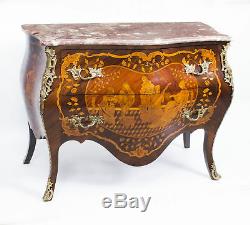
- Home
- Department
- Features
- 8-day (17)
- Aceo, Miniature (6)
- Antique (31)
- Boxed (6)
- Carvings (25)
- Decorative (17)
- Dragon-antiques.com (6)
- Framed (30)
- Framed, Signed (5)
- Gilded (76)
- Gilded, Pair (67)
- Hand Painted (14)
- Limited Edition (7)
- One Of A Kind (ooak) (12)
- Ornate (12)
- Pair (129)
- Reclaimed (13)
- Salvage (47)
- Signed (17)
- Updated Wiring (7)
- ... (3026)
- Material
- Subject
- Theme
- Type
- Andiron (21)
- Armchair (64)
- Candelabra (32)
- Candlesticks (39)
- Chandelier (98)
- Clocks (33)
- Desk Clock (28)
- Flatware - Sets (34)
- Lamps (26)
- Mantel Clock (21)
- Mirrors (39)
- Painting (45)
- Photo Frame (26)
- Picture Frames (46)
- Print (25)
- Sconce (228)
- Side Table (22)
- Sofa (47)
- Vase (23)
- Wall Clock (20)
- ... (2653)
Antique French Louis XV Revival Marquetry Commode Chest c. 1880



Regent Antiques has been trading in London for three decades. We specialise in English and Continental antique furniture, silver and porcelain. Our main markets are Europe and North America and we export worldwide. Antique French Louis XV Revival Marquetry Commode Chest c. This is a stunning antique French Louis XV Revival rosewood and satinwood.
Commode, circa 1880 in date. This gorgeous commode has two capacious drawers for ample storage, and was inspired by the Louis XV style. Elaborately detailed, the commode features an exquisite marquetry inlay of rosewood, amaranth, tulipwood, ebony and satinwood with three Bois Violette shaped panels inlaid with musicians and scenes of dancing at court.
To complete the fascination of this wonderful commode it is surmounted with a beautiful Breche Violette marble top. The elaborate marquetry decoration is further complimented by the exquisite gilded. Mounts that retain their original gilding.
A lot of intricate workmanship by a master craftsman has gone into the creation of this wonderful commode. In really excellent condition having been beautifully cleaned and polished in our workshops, please see photos for confirmation. Height 89 x Width 115 x Depth 55. Height 35.0 x Width 45.3 x Depth 21.7.
Is decorative artistry where pieces of material (such as wood, mother of pearl, pewter, brass silver or shell) of different colours are inserted into surface wood veneer to form intricate patterns such as scrolls or flowers. The technique of veneered marquetry had its inspiration in 16th century. Marquetry elaborated upon Florentine techniques of inlaying solid marble slabs with designs formed of fitted marbles, jaspers and semi-precious stones. This work, called opere di commessi, has medieval parallels in Central Italian. Work of inlaid marble floors, altars and columns.
The technique is known in English as. Chapel of the Medici at San Lorenzo. Is completely covered in a colored marble facing using this demanding jig-sawn technique. Techniques of wood marquetry were developed in. And other Flemish centers of luxury. During the early 16th century. The craft was imported full-blown to France after the mid-seventeenth century, to create furniture of unprecedented luxury being made at the. Royal manufactory of the Gobelins. Charged with providing furnishings to decorate. And the other royal residences of. Early masters of French marquetry were the Fleming. Who founded a dynasty of royal and Parisian cabinet-makers. And gave his name to a technique of marquetry employing shell and brass with pewter in.Violet Breche marble is extracted from the town of Serravezza, near to the Carrara region in Italy. It is a very heterogeneous marble made up of hues going from white to dark violet, whilst passing through shades of pink, all combined together with a violet coloured cement. In his Dictionary of Business and Industry, Blanqui describes Violet Breche. This marble that is frequently used on the most beautiful churches in Italy, and is found on several tables and columns in the galleries of the Louvre Museum, offers an elegant detail to monumental architecture. The quarries that produce it are several miles from Serravezza, and are found in the commune of Stazzema.
When the fragments which make up Violet Breche are large, in other words, when the lilacs, pinks, and whites, are prominent, it can only be used for monumental architecture, but when the colours are less prominent and equally spread across the whole surface of the marble, it can be used to make fireplaces and luxurious furniture. Ormolu (from French'or moulu', signifying ground or pounded gold) is an 18th-century English term for applying finely ground, high-carat. The mercury is driven off in a.
Leaving behind a gold-coloured veneer known as'gilt bronze'. The manufacture of true ormolu employs a process known as mercury-gilding or. In which a solution of. Is applied to a piece of. Or bronze, followed by the application of an.The item was then exposed to extreme heat until the mercury burned off and the gold remained, adhered to the metal object. No true ormolu was produced in France after around 1830 because legislation had outlawed the use of mercury. Therefore, other techniques were used instead but nothing surpasses the original mercury-firing ormolu method for sheer beauty and richness of colour. Is the most common modern technique. Ormolu techniques are essentially the same as those used on.
Take a tour of our London showrooms. Take Piccadilly line to Manor House station.
Go to top of escalators and turn left. Take exit 7 and walk straight on for 10 metres. Manor Warehouse is on the right. There is car parking available on site. Please make all cheques payable to Regent Antiques. Bank details: Regent Antiques - BBVA - Account: 05701615 - Sort: 23-59-11. For the best value, we recommend offsetting this cost by purchasing multiple items. The item "Antique French Louis XV Revival Marquetry Commode Chest c. 1880" is in sale since Monday, March 20, 2017. This item is in the category "Antiques\Antique Furniture\Chests of Drawers\Victorian (1837-1901)".The seller is "regentantiquesuk" and is located in London N4 1BX. This item can be shipped worldwide.

